What began as a celebration of popular children’s book author Beverly Cleary’s birthday April 12 (she turns 100 this year!), National Drop Everything and Read (D.E.A.R.) Day has become an annual monthlong celebration. Here is a selection of recently published books—from picture books to short stories for teens—to read aloud and add to classroom libraries for independent reading. Join in the D.E.A.R. celebration by dropping whatever you are doing and read for a period of time each day during April or, better yet, keep the celebration going throughout the year.
Ages 4–8
Amelia Bedelia on the Job (Amelia Bedelia #9). Herman Parish. Ill. Lynne Avril. 2016. Greenwillow/HarperCollins.
 The silliness of Herman Parish’s books about literal-minded schoolgirl Amelia makes the Amelia Bedelia early chapter book series a favorite of young readers. In this latest book, Amelia’s class is learning about careers. Comments such as “pitching to clients” and “it was a slam dunk” have Amelia thinking her father is a baseball and basketball coach. She’s confused when he says he’s in marketing—it’s her mother who does all the grocery shopping. A field trip to Amelia’s father’s office gives the class some hands-on involvement in Mr. Bedelia’s marketing job.
The silliness of Herman Parish’s books about literal-minded schoolgirl Amelia makes the Amelia Bedelia early chapter book series a favorite of young readers. In this latest book, Amelia’s class is learning about careers. Comments such as “pitching to clients” and “it was a slam dunk” have Amelia thinking her father is a baseball and basketball coach. She’s confused when he says he’s in marketing—it’s her mother who does all the grocery shopping. A field trip to Amelia’s father’s office gives the class some hands-on involvement in Mr. Bedelia’s marketing job.
Flying Frogs and Walking Fish: Leaping Lemurs, Tumbling Toads, Jet-Propelled Jellyfish, and More Surprising Ways That Animals Move. Steve Jenkins & Robin Page. Ill. Steve Jenkins. 2016. Houghton Mifflin Harcourt.
 A brief informative text and Jenkins’s signature torn- and cut-paper collage artwork offer an engaging look at surprising ways in which animals move. The exploration of each of various types of movement (walking, leaping, swimming, climbing, flying, rolling, and jetting) begins with a question introducing one animal with an unusual adaptation. For example, “Have you ever seen…A Walking Octopus?” A brief explanation of the octopus’s use of two of its eight legs to walk on the ocean floor is followed by a spread showing examples of five or six animals with other unusual adaptations for walking. A final spread provides brief notes on the animals.
A brief informative text and Jenkins’s signature torn- and cut-paper collage artwork offer an engaging look at surprising ways in which animals move. The exploration of each of various types of movement (walking, leaping, swimming, climbing, flying, rolling, and jetting) begins with a question introducing one animal with an unusual adaptation. For example, “Have you ever seen…A Walking Octopus?” A brief explanation of the octopus’s use of two of its eight legs to walk on the ocean floor is followed by a spread showing examples of five or six animals with other unusual adaptations for walking. A final spread provides brief notes on the animals.
High? Low? Where Did It Go?: All About Animal Camouflage (The Cat in the Hat’s Learning Library). Tish Rabe. Ill. Aristides Ruiz & Joe Mathieu. 2016. Random House.
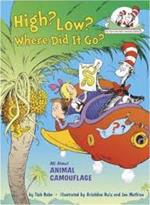 The Cat in the Hat takes a boy and a girl on a round-the-world trip to find hidden animals and gives them lessons on different types of camouflage: concealing coloration, disguise, disruptive coloration, mimicry, and countershading. Each type of camouflage is described briefly and illustrated with several examples of animals with that adaptation. The book ends with a challenge to find 10 hidden animals in a two-page illustration. Back matter includes a glossary and a list of related books.
The Cat in the Hat takes a boy and a girl on a round-the-world trip to find hidden animals and gives them lessons on different types of camouflage: concealing coloration, disguise, disruptive coloration, mimicry, and countershading. Each type of camouflage is described briefly and illustrated with several examples of animals with that adaptation. The book ends with a challenge to find 10 hidden animals in a two-page illustration. Back matter includes a glossary and a list of related books.
When Andy Met Sandy (Andy & Sandy). Tomie dePaola & Jim Lewis. Ill. Tomie dePaola. 2016. Simon & Schuster.
 In this new series for beginning readers, a text of short parallel sentences and dePaola’s signature artwork introduce Andy and Sandy, opposites who meet on a playground and become friends in spite of their different personalities as they share the fun of playing together on the seesaw. In the second book in the series, Andy & Sandy’s Anything Adventure (2016), Andy and Sandy find a special way of showing that they are best friends as the play dress-up.
In this new series for beginning readers, a text of short parallel sentences and dePaola’s signature artwork introduce Andy and Sandy, opposites who meet on a playground and become friends in spite of their different personalities as they share the fun of playing together on the seesaw. In the second book in the series, Andy & Sandy’s Anything Adventure (2016), Andy and Sandy find a special way of showing that they are best friends as the play dress-up.
Where’s the Elephant? Barroux. 2016. Candlewick.
 On the first spread there are three questions—“Where’s the Elephant? Where’s the Parrot? Where’s the Snake?”—and portraits of a gray elephant, a red parrot, and a green snake. This introduction leads readers to locate these animals hidden among brightly colored trees of various shapes on the wordless pages that follow. With each page turn, locating the three animals becomes easier as more and more trees are chopped down and their habitat shrinks as small houses and then bigger buildings and roads replace the trees—and the hide-and-seek game becomes a lesson on the effects of deforestation on animal inhabitants.
On the first spread there are three questions—“Where’s the Elephant? Where’s the Parrot? Where’s the Snake?”—and portraits of a gray elephant, a red parrot, and a green snake. This introduction leads readers to locate these animals hidden among brightly colored trees of various shapes on the wordless pages that follow. With each page turn, locating the three animals becomes easier as more and more trees are chopped down and their habitat shrinks as small houses and then bigger buildings and roads replace the trees—and the hide-and-seek game becomes a lesson on the effects of deforestation on animal inhabitants.
Ages 9–11
Animals That Make Me Say Ewww! (Ranger Rick). Dawn Cusick. 2016. Imagine!/Charlesbridge.
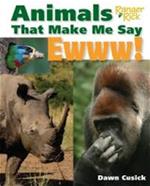 With the same format as Cusick’s Animals That Make Me Say Ouch! (2014) and Animals That Make Me Say Wow! (2014), this book is full of nature photographs of animals paired with brief paragraphs of information that will appeal to browsers. Cusick moves readers from some ewww-inducing photos to explanations of numerous adaptations animals have to help them survive. For example, a photograph of an oxpecker pecking at the nostrils of an African buffalo illustrates the symbiotic relationship between the bird and large mammal. The book includes four “Scavenger Hunt Challenges,” a list of other books by Cusick, a glossary, and an index.
With the same format as Cusick’s Animals That Make Me Say Ouch! (2014) and Animals That Make Me Say Wow! (2014), this book is full of nature photographs of animals paired with brief paragraphs of information that will appeal to browsers. Cusick moves readers from some ewww-inducing photos to explanations of numerous adaptations animals have to help them survive. For example, a photograph of an oxpecker pecking at the nostrils of an African buffalo illustrates the symbiotic relationship between the bird and large mammal. The book includes four “Scavenger Hunt Challenges,” a list of other books by Cusick, a glossary, and an index.
Escape From Wolfhaven Castle (The Impossible Quest #1). Kate Forsyth. 2016. Kane Miller.
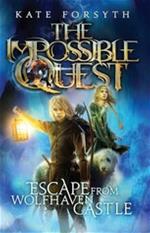 When Wolfhaven Castle is attacked, only four young people—Tom, the kitchen pot boy; Lady Eleanor, daughter of Lord Wolfgang; Quinn, the apprentice to the witch of the castle; and Sebastian, a squire—escape. With only a riddle and four magical gifts to guide them, they set out on a seemingly impossible quest to awaken four legendary magical warrior-beasts to save the kingdom. This first book in Forsyth’s The Impossible Quest series is a good choice for introducing readers to the fantasy genre. It is a well-crafted, fast-paced, and short book with an interesting cast of heroes, villains, and mystical beasts and lots of action. A bonus is that readers don’t have to wait for the next book in the series to be published. Kane Miller is releasing all five books, originally published by Scholastic Australia in 2014, at the same time.
When Wolfhaven Castle is attacked, only four young people—Tom, the kitchen pot boy; Lady Eleanor, daughter of Lord Wolfgang; Quinn, the apprentice to the witch of the castle; and Sebastian, a squire—escape. With only a riddle and four magical gifts to guide them, they set out on a seemingly impossible quest to awaken four legendary magical warrior-beasts to save the kingdom. This first book in Forsyth’s The Impossible Quest series is a good choice for introducing readers to the fantasy genre. It is a well-crafted, fast-paced, and short book with an interesting cast of heroes, villains, and mystical beasts and lots of action. A bonus is that readers don’t have to wait for the next book in the series to be published. Kane Miller is releasing all five books, originally published by Scholastic Australia in 2014, at the same time.
Sweet Home Alaska. Carole Estby Dagg. 2016. Nancy Paulsen/Penguin.
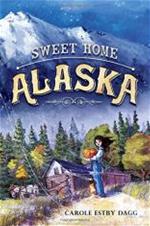 In 1934, the Johnson family takes advantage of one of Franklin D. Roosevelt’s New Deal programs and leaves Wisconsin to become a part of the homesteading Matanuska Colony in Palmer, Alaska. Eleven-year-old Terpsichore Johnson, inspired by Farmer Boy and other of Laura Ingalls Wilder’s Little House books, is determined to do all she can to help her family build a successful farm in the harsh wilderness and to convince her mother that they must stay and become a part of the Alaskan community she has come to love. Short chapters are filled with the adventure and hardship of pioneer life in Alaska in the 1930s and facts about the the Great Depression.
In 1934, the Johnson family takes advantage of one of Franklin D. Roosevelt’s New Deal programs and leaves Wisconsin to become a part of the homesteading Matanuska Colony in Palmer, Alaska. Eleven-year-old Terpsichore Johnson, inspired by Farmer Boy and other of Laura Ingalls Wilder’s Little House books, is determined to do all she can to help her family build a successful farm in the harsh wilderness and to convince her mother that they must stay and become a part of the Alaskan community she has come to love. Short chapters are filled with the adventure and hardship of pioneer life in Alaska in the 1930s and facts about the the Great Depression.
Turkeys Strike Out and Other Fun Facts (Did You Know?). Hannah Eliot. Ill. Aaron Spurgeon. 2016. Little Simon/Simon & Schuster.
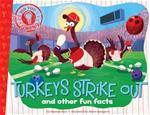 Eliot peppers the text of this new book in the Did You Know? series with questions related to sports and follows up with a rapid-fire mix of facts about the history of various sports, the popularity of different sports around the world, famous sports figures, sports lingo, and lots of trivia, leaving even the most knowledgeable sports fan saying, “I didn’t know that!” For example, did you know that the mascot of the Colorado Rockies is a purple triceratops named Dinger? It’s true, and Eliot tells why he became the team’s mascot. Cartoon illustrations featuring animals instead of people participating in sports add to the enjoyment of learning fun facts about sports.
Eliot peppers the text of this new book in the Did You Know? series with questions related to sports and follows up with a rapid-fire mix of facts about the history of various sports, the popularity of different sports around the world, famous sports figures, sports lingo, and lots of trivia, leaving even the most knowledgeable sports fan saying, “I didn’t know that!” For example, did you know that the mascot of the Colorado Rockies is a purple triceratops named Dinger? It’s true, and Eliot tells why he became the team’s mascot. Cartoon illustrations featuring animals instead of people participating in sports add to the enjoyment of learning fun facts about sports.
Ages 12–14
Everything Sports (Everything). Eric Zweig (with Shalise Manza Young). 2016. National Geographic Kids.
 This new book in the Everything series may not literally cover everything about sports, but it is packed with photos and facts about sports history, athletes, rules of the games, statistics, and trivia, all of which make this an informative, fun-to-read book whether you are a sports fan or not. With the Summer Olympic Games coming up later this year, features about the Olympics are of special interest. There is a quiz at the end of the book in the format of a glossary of sports-related terms and multiple-choice questions that tests your sports knowledge after reading the book.
This new book in the Everything series may not literally cover everything about sports, but it is packed with photos and facts about sports history, athletes, rules of the games, statistics, and trivia, all of which make this an informative, fun-to-read book whether you are a sports fan or not. With the Summer Olympic Games coming up later this year, features about the Olympics are of special interest. There is a quiz at the end of the book in the format of a glossary of sports-related terms and multiple-choice questions that tests your sports knowledge after reading the book.
Wonder Woman at Super Hero High (DC Super Hero Girls). Lisa Yee. 2016. Random House.
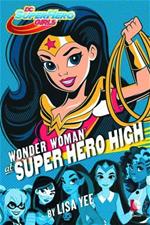 Disclaimer: I am not a fan of superhero comics, but I am a fan of author Lisa Yee. Curious to see how Yee would handle putting a teen Wonder Woman into a high school setting, I began to read how warrior princess Wonder Woman wants to move from the isolation of homeschooling on Paradise Island, where she lives with her mother, Hippolyta, the Queen of the Amazons, to being a student at Super Hero High. Yee succeeds in entertaining readers as she drops a rather clueless Wonder Woman into the mix of studies, cliques, friendships, and school rivalries (Super Hero High wins the coveted trophy for the one hundredth Super Triathlon) of this elite school for training superheroes of the future. “Wondy” successfully navigates the world of Super Hero High (as fans of Wonder Woman will expect) to become a student leader and Super Hero High’s Hero of the Month. She’s well on her way to her goal of making a difference to the entire world. The book ends with the promise of more to come.
Disclaimer: I am not a fan of superhero comics, but I am a fan of author Lisa Yee. Curious to see how Yee would handle putting a teen Wonder Woman into a high school setting, I began to read how warrior princess Wonder Woman wants to move from the isolation of homeschooling on Paradise Island, where she lives with her mother, Hippolyta, the Queen of the Amazons, to being a student at Super Hero High. Yee succeeds in entertaining readers as she drops a rather clueless Wonder Woman into the mix of studies, cliques, friendships, and school rivalries (Super Hero High wins the coveted trophy for the one hundredth Super Triathlon) of this elite school for training superheroes of the future. “Wondy” successfully navigates the world of Super Hero High (as fans of Wonder Woman will expect) to become a student leader and Super Hero High’s Hero of the Month. She’s well on her way to her goal of making a difference to the entire world. The book ends with the promise of more to come.
Ages 15+
I See Reality: Twelve Short Stories About Real Life. Grace Kendall (Ed.). 2016. Farrar Straus Giroux.
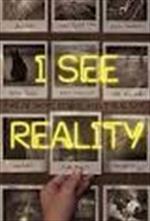 This collection of stories by a diverse group of young adult authors really delivers on the promise suggested by the title I See Reality. The 12 short stories are about teens dealing with real-life-in-the-real-world issues. Most of the stories are written from the first-person point of view, which makes them emotionally powerful as contemporary topics—pregnancy, abusive personal relationships, school shootings, sexuality identity, and more—are explored as teen protagonists make life-changing choices. I See Reality is an anthology that will leave teen readers wanting to read more stories by these talented young adult authors, so the inclusion of biographical notes on the authors and their writing is a bonus.
This collection of stories by a diverse group of young adult authors really delivers on the promise suggested by the title I See Reality. The 12 short stories are about teens dealing with real-life-in-the-real-world issues. Most of the stories are written from the first-person point of view, which makes them emotionally powerful as contemporary topics—pregnancy, abusive personal relationships, school shootings, sexuality identity, and more—are explored as teen protagonists make life-changing choices. I See Reality is an anthology that will leave teen readers wanting to read more stories by these talented young adult authors, so the inclusion of biographical notes on the authors and their writing is a bonus.
Stars Above: A Lunar Chronicles Collection. Marissa Meyer. 2016. Feiwel and Friends.
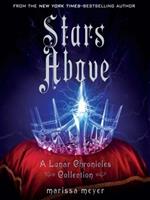 This collection includes nine short stories (five not published previously) with connections to the novels in Marissa Meyer’s popular The Lunar Chronicles series. The first story, “Keeper,” is a prequel to series. There are also prequels to individual books in the series from the first book, Cinder (2012), to the final book, Winter (2015), as well as an epilogue to Winter.Keeping the fairy tale connection going, “The Little Android” is a retelling of Hans Christian Andersen’s “The Little Mermaid” with a Lunar Chronicle setting. Finally, there is a two-chapter excerpt of Meyer’s upcoming novel, Heartless, about the Queen of Hearts from Alice’s Adventures in Wonderland, due out in November.
This collection includes nine short stories (five not published previously) with connections to the novels in Marissa Meyer’s popular The Lunar Chronicles series. The first story, “Keeper,” is a prequel to series. There are also prequels to individual books in the series from the first book, Cinder (2012), to the final book, Winter (2015), as well as an epilogue to Winter.Keeping the fairy tale connection going, “The Little Android” is a retelling of Hans Christian Andersen’s “The Little Mermaid” with a Lunar Chronicle setting. Finally, there is a two-chapter excerpt of Meyer’s upcoming novel, Heartless, about the Queen of Hearts from Alice’s Adventures in Wonderland, due out in November.
Carolyn Angus is former director of the George G. Stone Center for Children's Books, Claremont Graduate University, in California.
These reviews are submitted by members of the International Literacy Association's Children's Literature and Reading Special Interest Group (CL/R SIG) and are published weekly on Literacy Daily.